|
Back Marion Pennell mpennell@videotron.ca Montreal, Canada THE STORY OF JAMES' JOURNEY TO KNOWLEDGE "You never have to apologize for acquiring knowledge," [Alex Trebek] said, "even if it's not going to be of immediate benefit. Having knowledge makes you better able to understand the world in which we live." School gives your child skills, like reading and writing. We could think of those as apps. Knowledge is the content that gives you a reason to use those skills, like how the app uses your data. The more knowledge you have, the better you hone your skills. When I began giving drawing lessons to 8 year old James over Zoom this summer, we didn't know how it would play out. Now, in early December, our progress has exceeded my expectations. From about age 8 up to puberty they are sponges. James is not yet distracted and I can pile newer and more difficult concepts on top of the knowledge he has already so easily absorbed. I set up Mr. Dress-up style, low tech except for the Zoom connection. I, standing at my easel with a number of large sheets of paper, my markers, oil pastels, and some white paint (to explain erasing), and he, sitting at his desk, with enough sheets of paper that they are not precious, a pencil, manual pencil sharpener, crayons, and a good eraser. This is the kind of knowledge journey I will embark on with your child, if you so choose. You will understand my teaching methods, my thought processes, and my decision making with regards to your unique child. INTRODUCTION: GETTING TO KNOW EACH OTHER USING SUPERHERO LOGOS It's important to connect through the subject matter, so James chose superhero logos. We went through Batman, Robin, Superman, Flash, Wonder Woman, Aquaman, and Cyborg. I picked the images used for Batman and Superman, superheroes that were around even when I was a kid. But for the others, there were multiple versions, and certain heroes I never even knew, so James picked the version we used each week. As we got to know each other, conversations came up around superpowers and how you would use them. |
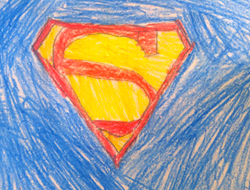
|
|
During this time I had to assure him that using an eraser was a good thing. Kids of a certain age are really resistant to the eraser. I showed him how many erasers I use, and how real artists use erasers all the time. A few times I used the white paint to erase some of my marker lines where shapes joined or crossed, so I could model it for him. His other accomplishment was learning to use any circular object (plate, bottom of the margarine container holding his crayons) to trace around in order to draw a circle. So we had passed the "I can't do it" phase. DINOSAURS: GETTING CREATIVE Next up was dinosaurs, beginning with the pterodactyl. James picked the animal for the next week, but not the image. Finally all the research was back in my hands, enabling me to pick simple profile poses of each beast that I could translate into easy step by step shapes for our lessons. Starting with the blank sheet we draw in real time together. I draw the head, and he follows, holds it up to show me, and so on. Superhero logos have to conform, the colours have to be correct. So I discussed how people don't know what colour a lot of the dinosaurs were, or whether they had feathers or not, so we can choose our own details. Where would a brown dinosaur live? A green one? We also start adding backgrounds, and James' choices revealed he was really thinking about his subject. |
James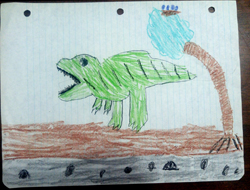 See the pterodactyl eggs in the tree? |
Teacher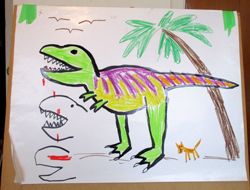 Yes, we discussed blood on the teeth. |
|
I wrote out the word PTERODACTYL (which James copied on his page without prompting) telling him how it is Greek for winged finger. I asked him to give his pterodactyl a name, and he chose Mango, which I also wrote out for him to copy. From there, in subsequent weeks, we drew T-Rex (to which he added pterodactyl eggs in a nest at the top of the tree), Ankylosaurus, Brachiosaurus, Stegosaurus, Triceratops, Spinosaurus, and Megalodon. We discussed what the animal would eat, and how it would use its own special tools or weapons, like a long neck, big teeth, armoured skin, and spikes on their tails. We had run out of the most popular dinosaurs and James decided we needed another one that lived in water. |
James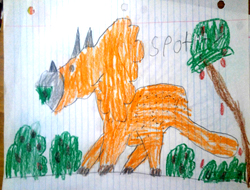 His name is Spot. |
James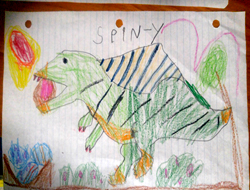 His name is Spiny. |
|
CROSS-CURRICULAR LEARNING BEGINS This is where we took the leap and bound to another realm. People in high school say "will I ever use this in real life? ". Well I am here to say that the answer is YES! For my grade eleven French sujet (finals, oral presentation) we had to prepare a number of topics and the evaluator (not from our school!) would engage us in conversation on one of those topics that they would choose on the spot. The advice was to prepare a bunch of boring ones, and one really interesting one, and chances are the evaluator would pick that one, so you only prepared that one in depth. My sujet was on the Loch Ness Monster (and other lake monsters, including Champ and Ogo-Pogo) and all the theories and "evidence" supporting its existence. It was less to persuade as to show how people take slight evidence to build complex theories. To this day, I remember the bulk of that sujet, as I studied so hard for it. The plesiosaur is one supposed identity of Nessie, so I took that opportunity to add a front lesson for James before the drawing lesson. I was prepared with notes this time as well as the requisite pencil sketch I use each week for reference while I draw freehand. After all the dinosaur conversations I noted he loves knowing and using big words (omnivore is a favourite), so it is easy to introduce new vocabulary. We got out the atlas for the first time to find the 3 lakes in question (Loch Ness, Lake Champlain, Lake Okanagan), and at this point I found out that he knew the basics of European exploration. He had heard of England and France and knew that they went out on ships and made a mistake and found Canada (pretty accurate actually). I broke down the word cryptozoology, (Greek again) explaining that there are a lot of "-ologies", and we talked about what a theory is. He understood crypto meaning hidden or coded or secret immediately, and told me about using pencil rubbings on notepaper to see the writing someone had made on the page that had been on top. I asked if he had ever gone fishing (they live in a town surrounded by beautiful Canadian Shield forests, so, yes) and whether he knew what a "fish story" was, and why exaggerating over silly things is not the same as lying about important things, (and why he should always tell the truth to his mom). |
James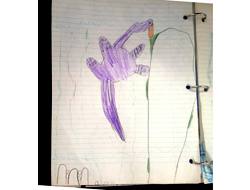 Eating the moss off the rocks. |
Teacher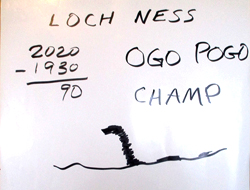 Approximation of the famous photo. |
| Many miles away Something crawls from the slime At the bottom of a dark Scottish lake |
|
I presented some of the evidence, including the sightings at Loch Ness in the 1930s once a roadworks project opened up the area, and Samuel de Champlain's journals from the 1600s. We got in the habit of subtracting any date from 2020, to figure out how long ago it was. I told him how all of the lakes used to be better connected to the ocean, how they were all very deep and hard to see, and very rocky. We discussed the real animals that are the most likely explanation for lake monster sightings. So after our chat, we began to draw together. We used the standard wave lines to represent being in water, and James added a big rock with some moss on the side for it to eat. He had effortlessly synthesized all the information into details in his drawing, and we chatted about this and related topics, like Bigfoot (do you mean the Yeti? he said) and I knew from here on our lessons would include a lot of new information and back and forth dialogue. AGE OF MAMMALS: Since we had run out of dinosaurs, he suggested the Sabre Tooth Tiger, which gave us a great opening into our next "-ology": biology! In a simple table we ran through the idea of Kingdom, what is an animal and what is a plant? And what is neither? He was great at this, and shows a real desire to be able to define and classify things. Vertebrates vs invertebrates (mainly bugs) came next, and how you can see the spine on a skeleton. Class has five easy to understand categories: fish, reptiles, amphibians, birds and mammals. Explaining mammals first as "basically all the other animals that are not in the other four categories" and then as giving milk to their babies. James turned 9 around this time, and he has a 3 year old brother and a baby sister on the way, so he has seen breastfeeding and knows that is feeding a baby. Next came the order Carnivora, and how it breaks down into cat, dog, bear, weasel, etc. families. And our cat Family is divided into three groups: the 5 main Big Cats, the rest of the cats including housecats, and our extinct cats, ie the Smilodon! We talked about the timeline of the dinosaurs being gone (because of asteroids! he chimed in) and how the big mammals lived alongside humans during the Ice Age. Why did the big mammals die and the smaller ones live? Fossils and the La Brea Tar Pits come up here too. We had the maps out to show where they lived in the Americas. |
James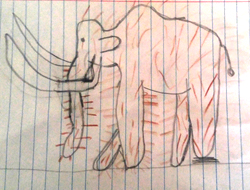 The tusks were tricky. |
Teacher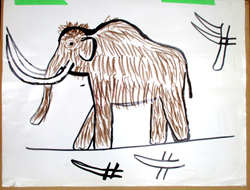 One tusk in front of the trunk, the other behind. |
|
The following week with the Woolly Mammoth, we reinforced the taxonomy aspect, having James name the Kingdom (animal or plant?), Phylum, and Class. Proboscidea gives way to Elephantidae, and we discuss African elephants, Asian elephants, Mammoths, and Mastodons (hint look at the ears, and the top of the skull - round, flat or two domes). He went into length describing how he imagined the mammoth used his giant tusks. I gave him one of those morbid true facts that kids love so much: in recent times sled dogs have been fed meat from frozen mammoth carcasses (at the edge of a thawing glacier). Since being hunted was part of their demise, I said that people do not have tusks or big teeth, but their special weapon is their brain. James told me that Adam and Eve got knowledge from God. I agreed, and said but we still have to go to school. Then we discussed what a baby can do (not much) and what his little brother can do, and how he can already do so much more. I said that God likes us using our brains since that's what He gave us in order to use the knowledge. SEGUE: Since Bigfoot had come up a few weeks ago, I asked James if it was okay to draw him the next week. It was time to come up with a new large theme, and I needed something good. We looked at the world map and found the Rocky Mountains, and The Himalayas in Nepal (India is that triangle sticking down, James). We talked about real things, and made-up things, and at some point I knew I had the best next thing. |
James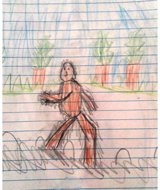 Just as convincing as any other evidence. |
Teacher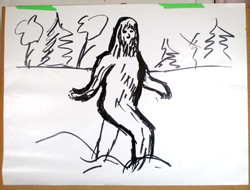 Stick with the classics. |
|
GREEK MYTHOLOGY: SO YOU CAN HAVE A CONVERSATION WITH ANYONE IN THE WORLD When I was in high school, we were lucky to have a teacher whose side interest was Greek mythology. He didn't need a textbook, his syllabus was his own memory. Each year, the grade 9 students would be grouped together in a small auditorium to hear his lectures, and if you know anything about Greek mythology, you know he kept our interest with all the sex and violence. I don't remember exams, so I am guessing maybe multiple choice? I still remember a lot about a lot of the myths, and I know they can also be told in a kid-friendly way. I have a friend who is a single dad, and although he is an atheist, he told me he would raise his son telling him all about the Bible stories and all about Greek mythology so that "he would be able to have a conversation with anyone in the world". I had to check ahead of time if James was in the know about Santa, and he is, so I was able to use that as an example of a myth. I also reinforced that he is on the grown up team now and has to keep up the story for his little brother. I told him how there are many versions of a myth, but the main thing is that it is a famous story, but not real. I know James is being raised Catholic, and I will never step on anyone's toes where that is concerned, so the intro was the difference between God (singular, capital G) and gods (plural, small g). I explained it was before Jesus, and this was how the people used stories to understand the world. And then I told him to be prepared because some of these stories are CRAZY!! There are a lot of gods with different powers and some are good guys and some are bad guys, and the bad ones are really bad. There are a lot of monsters, and some are half person and half animal, and the gods have children all over the place, and some of them are just people, but some have powers, and some are even monsters. |
James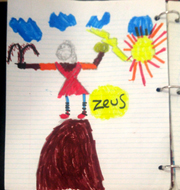 James added the eagle and a proper Mount Olympus |
Teacher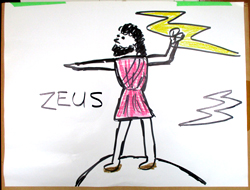 Simple and stylized. The thunderbolt, the beard, and the tunic makes it Zeus. |
|
I also told him how these stories are so famous that people copy them all the time. For example Wonder Woman is an Amazon, and a lot of superhero stories are copying parts of the stories of Greek mythology. (See how the knowledge relates back to the beginning again?) Now that you know me, and can see my train of thought when I teach your child, I hope you will trust that I can take your child on a similar or wholly original knowledge journey with drawing lessons. Contact me mpennell@videotron.ca. Next: Zeus, the Minotaur, and Hercules… How's your Greek mythology? 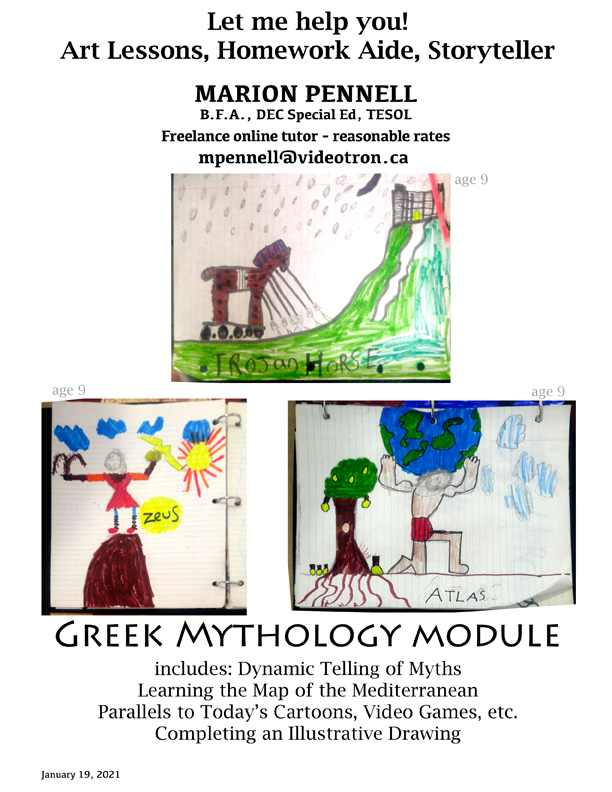 |